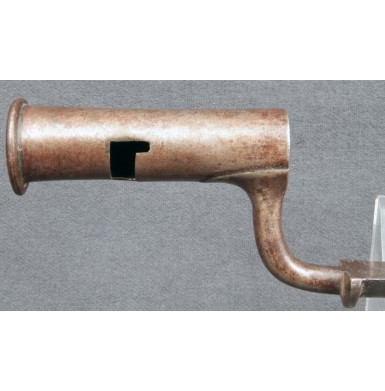British Land Pattern Brown Bess Bayonet - Pre 1750
- Product Code: EWB-1555-SOLD
- Availability: Out Of Stock
-
$0.00
This is a really fine condition example of the earliest regulation British military socket bayonet. The Land Pattern Socket Bayonet was the first somewhat standardized socket bayonet utilized by the British military. Prior to the adoption of this pattern, the bayonets were procured at the whim of the Colonel who raised and equipped the regiment, leaving lots of leeway in the quality and specifications of the bayonet. The British Board of Ordnance did not uniformly supply socket bayonets to the infantry until circa 1740, so prior to that point in time, great variations in bayonets are noted. These first “standardized” Land Pattern socket bayonets were based upon “hollow triangular blade” socket bayonets that first appear in regimental Colonels procurements circa 1715. Surviving documentation from the Board of Ordnance is almost non-existent for that period, but it is known that two “patterns’ of socket bayonets were adopted, one in 1728 and another in 1768. No doubt additional pattern changes (even if minor) occurred between these two official patterns. For a detailed discourse on the socket bayonet as used on the Brown Bess Muskets, I highly recommend Erik Goldstein’s The Socket Bayonet in the British Army 1687-1783. Research by Goldstein and English bayonet researcher Graham Priest have established a series of features that allow us to classify the Bess bayonets chronologically, based upon their physical characteristics. The most readily identifiable feature of the earliest Land Pattern socket bayonets is the pronounced i>shield shaped juncture between the shank and the socket. According to their research this was really a decorative feature, not unlike the “Beaver Tail” relief cut embellishment on the wrist of Brown Bess muskets, and the relief carving that appears around the side plate and lock areas of early Bess pattern muskets. It has been established that this very distinctive decoration disappears from the bayonets circa 1750, so its presence of this feature allows the bayonet to be reliably dated to 1730-1750.
This early Land Pattern Socket Bayonet is a classic example of 1730-1750 production. The bayonet features a pronounced “shield” filed at the shank-socket juncture. The bayonet has the usual hollow, triangular blade that is typical of these bayonets, that tapers to a very thin point. The critical dimensions of the bayonet are:
Overall Length: 19 ““
Blade Length: 15 3/8” (to shank) / 14 ““ to end of actual blade.
Socket Length: 4”
Muzzle-Stud Distance: 2”
Bore Diameter: .956” / 24.3mm
The bayonet is a nice, unaltered example of these very scarce, early production bayonets. The mortise remains very narrow and the final cut in the three-step mortise remains very short. The early Bess muskets had very narrow bayonet lugs, which were set 2” from the muzzle. Subsequent patterns of muskets had wider bayonet studs, and eventually, they were moved closer to the muzzle, resulting in a shorter muzzle-stud distance. This resulted in the mortises of the existing bayonets in store being widened and eventually having the third step in the mortise cut extended to match new stud mounting distances. The wider studs start to appear around 1740-1745, so this indicates that this bayonet is probably earlier than that. This bayonet has not been modified for use on these later pattern muskets and remains in its original c1735 configuration. The other feature helpful in dating the bayonet is the existence of the reinforcing ring at the rear of the socket. The rear of the socket shows a crude lap weld joint, typical of the earliest bayonets to have this feature, which appear around 1730. The Ordnance Board procured bayonets of this era are rarely maker marked, but do appear with numbers on the blade and socket and the Board of Ordnance ownership mark, a small Crown & “Broad Arrow” mark on the shank, immediately to the rear of blade. This bayonet is marked on the blade with the number 3 twice, on above the other. The shank also appears to have the faint remnant of the Crown-Broad Arrow mark, but it is barely visible. The blade of the bayonet shows a fantastic diagonal weld line, where the iron socket and rear portion of the blade were welded to the front steel portion of the blade. The bayonet has a lovely, totally untouched and un-cleaned patina. The metal is mostly smooth, with only some scattered patches of minor peppering and pinpricking, and only the most minor scattered light pitting. Overall the bayonet rates at least VERY FINE, especially when the age of the bayonet is taken into consideration “ it is at least 260 years old!Overall this is a really outstanding example of a very early and completely unaltered British Board of Ordnance Land Pattern Socket bayonet, from about 1740. This bayonet could have easily seen service in North America during the Seven Years War (French and Indian War), and subsequently during the American Revolution. Finding early British Board of Ordnance bayonets in this kind of completely unaltered and untouched condition is very rare and this would be a fantastic addition to any early British military collection or an advanced bayonet collection.
SOLDTags: British, Land, Pattern, Brown, Bess, Bayonet, Pre, 1750







